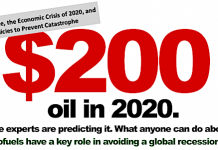Tom Konrad CFA
Bargain hunters looking for opportunities in muni bonds should be mindful of peak oil.
Meredith Whitney predicts a wave of defaults in municipal (muni) bonds, followed by indiscriminate selling and potential buying opportunities for some. She’s been widely criticized for the prediction of defaults, but I’m a lot more interested in the prediction of the market’s reaction.
With tax-free, AAA-rated munis currently yielding more than comparable taxable Treasury bonds, they seem at least a relative bargain already. I would not call it outright panic, but I’d expect there are be some bargains to be had. Yet muni bonds’ relative illiquidity and high brokerage commissions make short term trading in munis inappropriate for most investors. If you are in a high tax bracket, and want long term income, they often make sense when held to maturity. Yet if you intend to hold a muni bond for five to twenty years, it’s all the more important that the interest on offer fully compensate for the risk of default.
Types of Muni Bonds
I spend most of my time analyzing stocks, so I’m not going to claim I can find those muni bond bargains that are probably out there, but I’m pretty confident I know a couple places not to look.
If you want to understand the risks of a muni bond, you need to know what revenues back up the bond you’re interested in. If those revenues are safe, then so is the bond. General Obligation (GO) bonds are backed by tax rolls, which may be able to be raised if a municipality gets into trouble… provided the citizens would not rather have their municipality default and take the consequences. Revenue bonds, on the other hand, are backed by the revenue of the project they were issued to finance (The Obligator.) Obligators can be water and waste water utilities, toll roads and bridges, hospitals, airports, transit authorities, or universities: The obligator can be any enterprise that a municipal borrower undertakes that has its own identifiable revenues.
Risks to Obligator Revenues
There are any number of risks to these revenues. For instance, CERES recently released a report (PDF) highlighting the risks of diminishing water supplies to muni bonds, discussed in this recent Renewable Energy World podcast. It’s not only water utilities that face risks of diminishing water supplies, but even GO bonds could be affected if there is not enough water in the future to support a population large and vibrant enough to repay the bonds.
Climate risks may also play a role. In addition to water scarcity exacerbated by climate change, increasingly powerful hurricanes do not improve the credit worthiness of cities in the hurricane belt. Rising seal levels will also add costs for flood protection in coastal cities, and larger floods will do the same for cities on major rivers. That could affect GO bonds, or the bonds of city water and sewer systems.
Probably the largest near-term resource risk for muni bonds is peak oil. Rising oil prices will do most of their damage to car-dependent communities, and so exurban and rural GO munis may be much riskier than they appear. Diminishing car traffic could easily undermine the economics of toll roads and bridges at the same time as it increases maintenance costs by increasing the cost of asphalt. Municipal parking garages also seem risky.
Airports are also at risk, particularly small ones. A recent New York Times article looked at how small airports are increasingly feeling the pinch as higher fuel costs drive up airfares at small airports (which are served by smaller planes using more fuel per passenger) faster than at large ones, and travelers increasingly choose to drive to larger hubs for fares. As regional airports close, larger airports may gain somewhat, but will it be enough to offset overall air traffic declines? And as smaller regional airports close, will that begin to undermine the appeal of air travel altogether, leading many people to take fewer trips or travel by bus or train?
Winners as Well as Losers?
Some munis might be helped. As noted above, large airports might gain revenue at the expense of small ones, although that seems a risky bet if peak oil leads to a long term overall decline in air travel.
Transit authority muni bonds seem more attractive. Transit powered by electricity, such as subways, much rail transit, and trolley buses have the added advantage of fuel costs that are largely uncorrelated to the price of oil. If such transit authorities benefit from increased ridership as commuters look for alternatives to increasingly expensive cars, their bonds should be much safer than many investors expect. I’ve long been an advocate of investing in mass transit stocks as a hedge against peak oil. Muni investors have an advantage over stock investors: they can get exposure to transit authority revenues through municipal bonds.
Conclusion
The muni bond market is large and varied, and there are many other factors to consider in addition to resource constraints. With many investors already selling, there are probably bargains to be had. Yet today’s municipal bargains may still become tomorrow’s screaming deals, especially with more downgrades coming. I think there’s more room for the indiscriminate selling Whitney talks about. When I see that, I’ll be looking for munis backed by municipal transit authorities of large cities outside the hurricane belt.
DISCLOSURE: None.
DISCLAIMER: The information and trades provided here are for informational purposes only and are not a solicitation to buy or sell any of these securities. Investing involves substantial risk and you should evaluate your own risk levels before you make any investment. Past results are not an indication of future performance. Please take the time to read the full disclaimer here.






